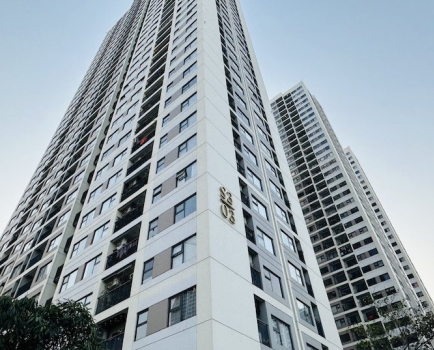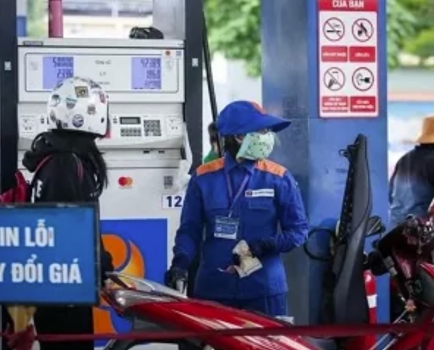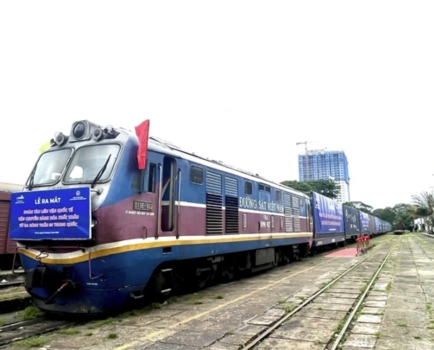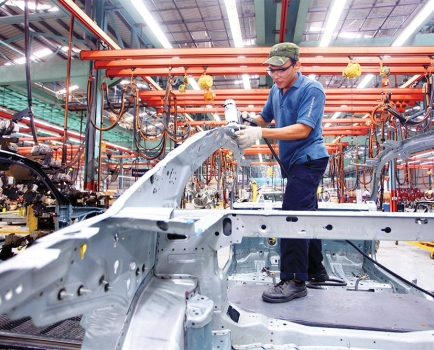Authorities apathetic as Red River is sand-mined to death
Wed, 06 Nov 2019 17:03:00 | Print | Email Share:
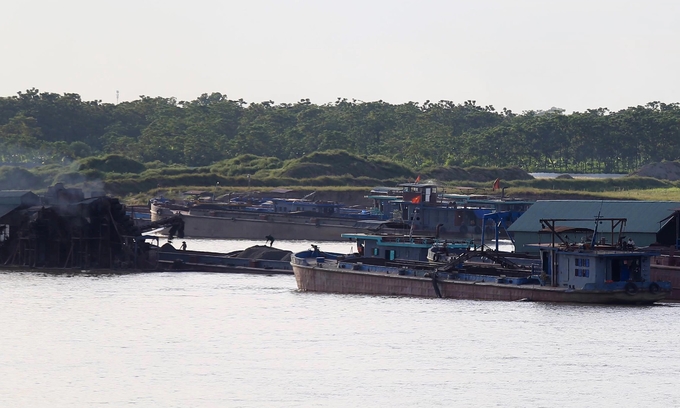
that flows near the border of Hanoi and Vinh Phuc Province, July 5, 2018.
Photo by VnExpress/Gia Chinh.
Binh still remembers vividly the sleepless nights. He kept his flashlight charged and his ears cocked for the phone to ring.
When it did, as it did often that summer of 2016, he would rush to the Am Sa alluvial plain by the Red River in order to support other men as they tried to deter and drive away thieves who came to illegally mine the river for sand.
Binh, as the leader and the oldest of the vigilantes, got some time in the night to lie down in his house. Other members of the task force, over 10 residents of the Bac Son Village near the river, were up every night, keeping a lookout.
The men divided themselves into teams to guard the river bank in two shifts. They would hide in a banana grove along the bank and throw bricks to chase away the sand miners.
In the dark of the night, large boats with no registration would approach the river bank slowly. Pipes would plunge into the river bed and suck sand into the boat.
The boats would be met with a hail of bricks chucked from the banana grove.
Most times, the bricks would fail to reach the boats, falling far short. The noise and commotion would catch attention of people on the ship, but that would not scare them away or stop them from doing what they set out to do.
The villagers of Bac Son could not do more. If they engaged in any direct violence with the sand stealers, they would get into trouble with the law.
Bac Son Village in Hung Ha District of Thai Binh Province, two hours southeast of Hanoi, owns two alluvial plains, a gift from the Red River, which flows from Yunnan Province in Southwest China through northern Vietnam to the Gulf of Tonkin.
On the two plains, Am Sa and Tan Boi, local residents planted banana and mulberry. Ever since the plains were formed, they had never been flooded. The people of Bac Son had never seen their farms under water. The seasonal flooding never affected them directly.
Until 2012.
That year, a local company got the green light to exploit sand in the area. It turned out the sand there was perfect for construction projects. The sand mines that surrounded the two plains and kept them in shape now became instruments of destruction. In the wake of that one licensed company, other boats flocked to the area, most of them illegal. Night and day, they sucked the sand out of the river.
In late 2012, the Tan Boi plain gradually disappeared into the river and in the summer of 2016, serious erosion of the Am Sa plain began.
The villagers of Bac Son fought back. They set up the task force, ambushed and threw bricks at the illegal sand miners. They went to the local town to rope in professional photographers, hoping that pictures of the sand mafia would prompt authorities police to swing into action. But no photographer agreed to take the deal, even when the payment equaled what they could earn for two wedding photo shoots, and the job was much easier. They were scared, saying no one could guarantee if the sand miners would not come for them later.
With their hands tied, villagers appealed directly to local authorities and their petition went on to reach provincial authorities. However, when the police came to inspect, there were no sand-mining boats to be seen. Once the police left, the boats reappeared.
Today, there is no vigilantism, no task force to fight the illegal sand mining.
Today, when Binh flings a brick from the banana grove, it sinks into the water that used to be the Tan Boi plain. It’s all water.
Lost sanctity
For Vietnamese people, the Red River is not just any river. It is the fount from which their civilization sprang before expanding to the south.
For centuries, the people of the Red River Delta have had the tradition of praying to the river for peace, prosperity, luck and safety. They have even built temples alongside the river for the ritual.
However, the sanctity of the river seems to have been buried by "development," under a barrage of concrete buildings. And in order to supply such buildings with increasingly scarce and expensive sand, the river has become a resource opened up to uncontrolled, haphazard exploitation.
As the construction industry thirsts for sand, conflict, crime, fines and even jail terms are unable to deter from the sand rush, with all the crazy characteristics and harmful impacts of a gold rush.
Needless to say, treating Mother Nature so badly has very adverse, far-reaching consequences.
In 2010, when the capital city celebrated its millennial anniversary, the water level in the Red River was measured at just over half a meter, the lowest in 200 years.
The overexploitation has caused the river to change in many aspects. Naturally, when the river bed sinks, water levels will drop, not only in the dredged sections, but also in upstream areas. And with a lower bed, the river’s velocity increases, groundwater levels along its banks drops, and erosion becomes rampant.
The people of the Red River Delta, once a fertile and peaceful land, have started to worry for their farms, and worse, for their houses and lives.
Disappearing acts
The shape of the Red River’s section that flows through Hanoi, Vietnam’s capital city, has changed dramatically since 1989. It has shrunk. A big part of it, which used to run between Me Linh and Dong Anh Districts, has now disappeared. On the east side of what is now the Nhat Tan Bridge, the water level has dropped so significantly that a new plain has come into view.
For Hanoian in the city's downtown area, the change is starkly evident.
In the 80s and 90s, the plain near the Long Bien Bridge was completely separated from the city’s downtown area thanks to a branch of the Red River. Today, that branch has disappeared. To be exact, it has turned into what could be called a flooded area, and not very far from that area, a new plain is being formed.
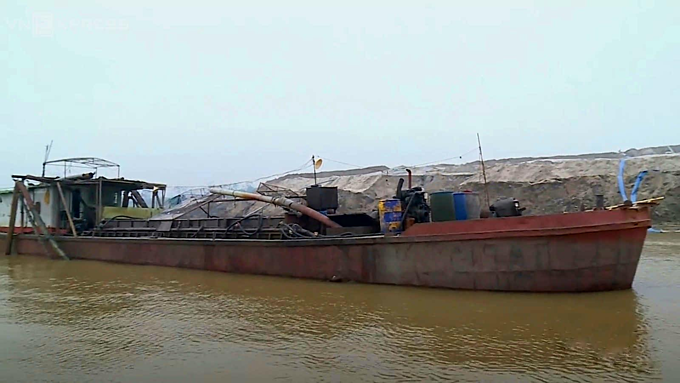
A barge used for illegal sand mining along the banks of the Red River
in Hanoi in January 2018. Photo courtesy of the Hanoi police.
Low water levels in the Red River have led to a series of consequences: coastal erosion, lack of water for production and daily activities, requiring hydropower reservoirs having to discharge to compensate, which in turn affects energy security, not to mention salt intrusion, environmental pollution, and adverse impacts on waterway traffic.
According to the Vietnam Academy for Water Resources, there are two reasons that have caused the riverbed to sink: upstream dams that hold back alluvium, and overexploitation of sand.
Since upstream reservoirs are legal entities, there’s some openness to arguments, objections and counter-proposals, but the boats and barges that suck sand from the river bed remain a mystery hidden in plain sight.
There are several many reasons the dredging vessels and sand miners behind them don’t get identified and dealt with.
Global demand for sand and gravel, which is used extensively in construction, is about 50 billion tons or an average of 18kg (40 lb) per person per day, according to a report published in May by the UN Environment Program (UNEP).
Sand and gravel resources are the second-largest resource extracted and traded by volume after water.
Extraction in rivers and beaches has increased pollution and flooding, lowered groundwater levels, hurt marine life, and exacerbated the occurrence and severity of landslides and drought, the report said.
It quoted Joyce Msuya, then UNEP's Acting Executive Director, as saying: "We are spending our sand 'budget' faster than we can produce it responsibly."
Current legal frameworks are not sufficient, and "sand mafias" comprising builders, businessmen and dealers in countries such as Cambodia, Vietnam, India, Kenya and Sierra Leone regularly flout existing laws, the UNEP said.
Sand began to be referred to as "India’s gold," and its mining has destroyed numerous rives across the country, despite crackdowns on illegal operations.
A 2017 Reuters article said the Indian states of Gujarat and Maharashtra were the main hotspots for illegal extraction of sand in the country, generating about $150 million a year meeting demand from the construction sector.
Yet unlike in India where sand miners have to dive into pitch black waters, Vietnamese sand miners just send their boats and use pipes to suck the sand from riverbeds.
Mafia at work
At the junction of Hanoi and Vinh Phuc Province, the Ministry of Public Security in 2014 had carried out the biggest raid ever against sand miners. The raid was carried out by the ministry’s police force and Hanoi’s police department without any prior warning given to local police.
Sixteen dredgers, three crane vessels, and more than 30 boats and barges used to carry the sand were seized and dozens of sand miners were arrested. Police also seized different types of weapons from each boat, indicating clearly the mafia nature of illegal sand mining.
It was found that operating under the protection of a mafia gang and using the cover of a commercial joint stock company that had changed its business license as many as seven times, the group was exploiting sand from seven locations in the middle of the river. According to the police, the group got sand in the night from Phu Tho to Vinh Phuc and then back to Hanoi, generating VND1 billion ($43,000) each day from selling 2,000 cubic meters of sand.
When authorities in Phu Tho came for inspection, the group would say they were mining sand in Vinh Phuc, and Vinh Phuc authorities were told it was sand from Hanoi.
This fragmented waterway management has for years facilitated illegal sand mining in northern Vietnam.
Eventually, Vu Anh Toan, the leader of the ring, received 38 months in jail and the case ended there. But that case was a rare one in which sand miners were charged with a crime and taken to court.
In the past two years, police have detected 13,000 cases of illegal sand mining in which more than 4,000 people had been investigated. But so far, just seven cases and as many people have been charged with "violating regulations in researching, exploring and exploiting natural resources."
Senior officials of the Ministry of Public Security have said earlier that it was difficult to press criminal charges because authorities had to prove that the miners have pocketed more than VND100 million ($4,300) in a single case or the value of the sand exploited must exceed VND500 million. Until now, there is no mechanism that authorities have to calculate this.
Furthermore, many businesses have been using the cover of dredging and upgrading of inland waterways to get the sand from right under the noses of authorities.
Others choose a different way: get a license to exploit sand at first and start illegal mining through the backdoor, expanding operations without permit and using locals as miners.
"If the police find out, then it is those miners that would get caught, while those companies just walk away free. And in case miners do get the sand, they will have to sell it to those companies at just half the market price," said a sand dealer who wanted to stay anonymous.
Miners who agree to work for such companies never have to worry about consumption because as long as they can get the sand, dealers will buy it, no questions asked.
In the next step, these companies sign contracts to provide sand to the market where there is huge demand from large-scale construction sites and big companies as well as smaller works in residential areas. This helps legalize the illegal mining. At the end of the day, the companies are able to produce legal invoices for market inspectors.
Living in fear
Thao has had trouble sleeping since the summer of 2017.
One night, she felt that her bed was tossing around like a boat in rough waters. What she heard was the sound of boats using their "trunks" to suck out sand from the river. Her house, which stands at the foot of a dam, kept shuddering. Scared out of her wits, Thao woke up the rest of the family, her two grandsons, her daughter and son-in-law. They ran out of the house and spent the rest of the night outside, waiting for the boats to leave.
The next morning, she reported the case to the authorities in Cam Dinh Commune. But as long as there was no regular patrolling by the police, the miners would be back.
Thao and her family have had no choice but to live with fear. For the past two years, they’ve not dared to make any structural changes to the house because the future has become uncertain.
In July last year, villagers in Cam Dinh Commune submitted a signed petition to Phuc Tho’s authorities, demanding strict measures against illegal sand mining.
More than 20 villagers visited the district’s office, and the officials received the petition. But all they did was tell the residents to go home, saying they have been aware of the situation for years but could not do anything about it.
Also last year, on the sidelines of a city’s council meeting, Chairman Nguyen Duc Chung showed the press a video in which two boats of illegal sand miners could be seen operating on a section of the Red River in Cam Dinh Commune just a few meters away from a boat of local waterway police.
The result of all this inaction from the part of authorities is that the bed of the Red River has got hollowed out. By 2012, the cross sectional area of the river had increased by 40 percent against over 2000, official data says.
"From 2000 to date, the riverbed has dropped by an average of eight centimeters each year," Asscociate Professor Pham Dinh from the Vietnam Academy for Water Resources said.
Many areas in the bed of the Red River that flows through Hanoi have subsided by two t0 three meters compared to five to ten years ago and at some locations, the subsidence is even eight to ten meters, Chu Phu My, director of Hanoi’s Agriculture and Rural Development department, told the Hanoimoi newspaper.
"There are different reasons causing this problem but the main one is still the illegal overexplotation of sand," he told the newspaper, which is managed by the party unit of Hanoi, in June.
The continuous drop in the Red River water level has led to the suspension of a series of projects that source the river’s water.
For the rice crop in late 2018 and early 2019, most riverside water stations could not operate as normal and as a result, dams had to release water to make up for the water loss.
If dams only needed to release 2.5 billion cubic meters of water back in 2008, the figure in 2018 was 5.74 billion cubic meters, data from the department shows.
No respite
Ever since Vietnam launched its economic renewal campaign Doi Moi that introduced reforms intended to facilitate the transition from a centralized economy to a "socialist-oriented market economy" in 1986, there has been only one time when the sand mining in Hanoi slowed down its speed: the period when the property market was in its peak of being frozen, just after 2011.
Pham Van Bac, head of the Building Materials Department under the Ministry of Construction, said the amount of construction sand that has been exploited legally, by 2016, was almost 692 million cubic meters.
Demand for sand, as per the department’s calculation, stayed at 50-60 million cubic meters per year in 2015, and the figure is expected to rise to 130 million cubic meters by 2020.
"The legal source could only meet 40-50 percent of the demand," Bac said. The market needs illegally exploited sand or alternative materials to keep up demand, he added.
Alternative materials could be manmade sand or ash from factories processing iron and steel that could meet standards to replace construction sand. One of the potential candidates for sand replacement now is the ash coming from coal-fired power plants, currently estimated at round 30 million tons.
But Vietnam is far behind in the race for finding alternative building materials. "Some localities have just stopped at setting criteria for alternative materials," Bac said.
In such a situation, the simplest solution is illegal sand mining.
When will it end?
Meanwhile, Thao’s sleepless nights continue. An embankment running along the river not far from her house was built just last year, but almost one third of it has already been lost to the river so far this year.
Thao says she has no idea when erosion would sweep her house away. That fear haunts her every night.
Last summer, Thao’s daughter Thom, took her children to her uncle’s house to teach them swimming. The uncle’s fish pond is the only place where those kids, who have no access to a proper swimming pool, can learn the skill.
As a kid, Thom learned how to swim in the Red River. Every summer day, she and other kids in the village would rush to the alluvial plain and jump into the river. Now, no adult dares to let their kids put even one leg into the river, given the potential dangers it poses because of the changes in its flow and the continued dredging of operation of sand dredging boats.
She said: "Maybe they will just keep taking sand until houses are swept away, dams are broken and water flows all the way to the central government, then we would hopefully see real action taken to put an end to illegal sand mining."
By: Hoang Phuong/Vnexpress
Source: https://e.vnexpress.net/news/news/authorities-apathetic-as-red-river-is-sand-mined-to-death-3982914.html
---------------------------------------------
Same category News :




